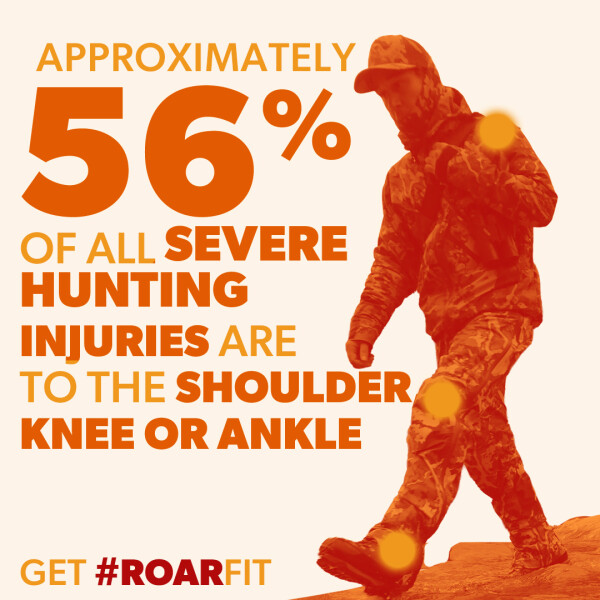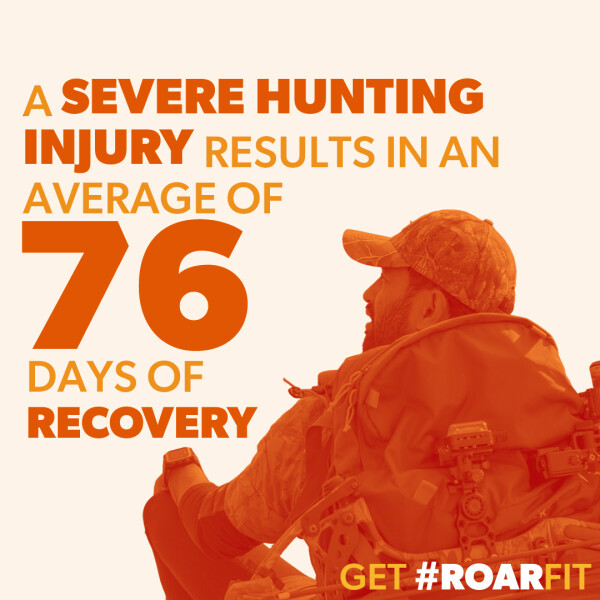The Roar is a highlight of the big game hunting calendar in New Zealand, with thousands of hunters heading into the hills to hunt male stags during the mating season in March and April. Start your fitness preparation early to ensure you’re in top hunting shape so you can cover more ground comfortably, stay injury-free and make the most of your hunting trip.
Download the ROARfit Guide today
Get Hunt Fit With Our #ROARfit Guide
Unfortunately, severe hunting injuries double during the Roar, compared to an average month. Your level of fitness is crucial for both your enjoyment and safety. If you’re hunt fit, you’re less likely to suffer an injury and more likely to have a great time.
To help you get into the best hunting shape, we’ve developed a free 12-week #ROARfit guide to support your fitness journey. If you have less than 12 weeks to get #ROARfit, don’t sweat it – any fitness is better than none, and the sooner you start, the fitter you’ll be! There’s no better time to start your fitness training than today.
- Start exercising. A great way to train or maintain your fitness for the Roar is to walk, tramp or go on shorter hunting trips.
- Be consistent. Going regularly is key. Choose an exercise you like, start small and build up slowly, especially if you’re out of practice.
- Introduce strength work. As you get fitter, include some weight training in your programme. Again, start small and increase weights gradually. This could be your pack weight or traditional weights at the gym or at home.
- Begin planning your hunt. Use the free Plan My Walk app or website to plan your route and build your trip plan.
- Research your hunting area. Once you’ve decided on your area, find out as much information as you can about it, consider the terrain, river crossings, facilities and access.
- Check your gear. Make sure your gear is in working order. Repair or replace any items now.
- Hit the hills. There’s no better way to get prepared than hunting in the hills on uneven terrain and steep climbs or descents. Take it easy, this is still training time.
- Take your pack. A loaded pack on your back will help you get #ROARfit. It will also help you decide if you need to cut down on weight, or if you’re missing any key items.
- Review your progress. How’s your training going? Do you need to increase your training? If you’re struggling, do you need to reset your goals for your Roar hunt?
- Build a Plan B. Plan your exit routes and decide what your group will do in an emergency, or if things don’t go to plan, for example if someone gets injured or the weather packs in.
- Check in with your mates. Talk to your hunting party and make sure everyone knows the plan and is getting prepared. Support and encourage each other.
- Check in with your mates, again. Make sure everyone knows the details for the hunt.
- Share the trip plan. Have an emergency contact and share the trip plan with them. Plan My Walk makes this step easy.
- Rest and recover before the big day. Taper off your training so you’re not overdoing it. Aim for an early night before you head out. The days can be long, so you want to be well rested and focused.
- Discuss your plan. Before you head off, make sure everyone in the hunting party knows the day’s plan.
- Watch the weather. Check the forecast and any weather warnings and keep an eye on the conditions on the hunt. To get the latest weather updates, sign up to Plan My Walk.
- Pack the essentials. Always take a rain jacket, warm layers, a warm hat and gloves, emergency shelter, first aid kit and a distress beacon or other two way comms device.
- Know your limits. If you're feeling fatigued, either physically or mentally, take a break, reassess your situation and check in with your group. Your top priority is always getting everyone home safe.
- Take care of yourself and each other. Eat, drink and rest regularly, stick with your group, and make key decisions together.
- Always follow the Firearms Safety Code.
Have a Hmmm this Roar
It’s easy to get caught up in the excitement of the hunt and push your limits. Make sure to ‘Have a hmmm’. That means:
- Slow down – this has benefits not only for your safety but also for your hunt. That extra pause may be the opportunity you need to see the game you’re looking for.
- Pay close attention to your route – take in your surroundings and track it on your map. It may make all the difference when you’re retracing your steps.
- Watch your footing – be deliberate with your foot placement to help prevent slips, trips and falls. You’ll also be quieter, so less likely to scare off game.
- Stay alert for terrain traps, like bluffs – ensure that you assess the landscape before committing to a route to avoid getting into trouble. If you end up in a tight spot, pause and consider the safest way out, even if it’s backtracking.
Questions People Ask About Getting Prepared for the Roar
Hunting during the Roar often involves covering steep and uneven terrain while carrying heavy loads. Good fitness reduces your risk of serious injury, improves your endurance, helps to keep you mentally sharp, and enables you to get more out of your hunt. MSC research shows that severe hunting injuries double during the Roar, with 40% of injuries affecting the knee or shoulder, with the average severe injury resulting in 76 days off work while you recover. Ideally, you should begin preparing at least 12 weeks before the hunting season to build endurance, strength, and pack fitness gradually. Even if you have less time, any preparation is better than none. Starting early helps you build up your training and ensures you can be in the best shape come hunting time. You can prepare by starting a consistent exercise routine at least 12 weeks before the Roar. Walking, tramping or shorter easier hunting trips provide a good fitness base. Gradually add strength training and hill work, then progress to training with a loaded pack. The free #ROARfit 12-week guide provides a step-by-step programme to help you build hunting fitness safely. Always create a trip plan and share it with a trusted emergency contact, check your gear before you go and ensure you’re carrying the essentials like warm layers, a warm hat and gloves, a rain jacket, first aid kit, head torch and a distress beacon. Pay attention to the weather, know your limits and support your hunting mates. Remember to ‘Have a hmmm’—slow down, check your route, watch your footing, and assess terrain traps to avoid slips, falls, or dangerous detours. Finally, always follow the Firearms Safety Code when out hunting.
What To Do Next
Explore our hunting resources
- Get prepared for a hunt | See our tips and resources for a safe and successful hunt
- Be firearms safe | Watch the video series on the seven basic rules of firearms safety
- Know the risks | Watch our video on big game hunting
Stay up to date with all our hunting tips and insights – subscribe to our hunting newsletter.
Read hunters’ stories
- Hunting Fitness: An Honest Conversation with Yourself
- Roar 2023 Adventure: Lessons Learned in the Wild
PHOTO CREDIT | Hunter's Journal
This page was reviewed and updated September 2025


